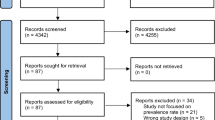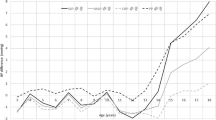Abstract
BACKGROUND
The burden of hypertension and related health care needs among Mexican Americans will likely increase substantially in the near future.
OBJECTIVES
In a nationally representative sample of U.S. Mexican American adults we examined: 1) the full range of blood pressure categories, from normal to severe; 2) predictors of hypertension awareness, treatment and control and; 3) prevalence of comorbidities among those with hypertension.
DESIGN
Cross-sectional analysis of pooled data from the National Health and Nutrition Examination Surveys (NHANES), 1999–2004.
PARTICIPANTS
The group of participants encompassed 1,359 Mexican American women and 1,421 Mexican American men, aged 25–84 years, who underwent a standardized physical examination.
MEASUREMENTS
Physiologic measures of blood pressure, body mass index, and diabetes. Questionnaire assessment of blood pressure awareness and treatment.
RESULTS
Prevalence of Stage 1 hypertension was low and similar between women and men (∼10%). Among hypertensives, awareness and treatment were suboptimal, particularly among younger adults (65% unaware, 71% untreated) and those without health insurance (51% unaware, 62% untreated). Among treated hypertensives, control was suboptimal for 56%; of these, 23% had stage ≥2 hypertension. Clustering of CVD risk factors was common; among hypertensive adults, 51% of women and 55% of men were also overweight or obese; 24% of women and 23% of men had all three chronic conditions-hypertension, overweight/obesity and diabetes.
CONCLUSION
Management of hypertension in Mexican American adults fails at multiple critical points along an optimal treatment pathway. Tailored strategies to improve hypertension awareness, treatment and control rates must be a public health priority.



Similar content being viewed by others
References
Ong KL, Cheung BMY, Man YB, Lau CP, Lam KSL. Prevalence, awareness, treatment, and control of hypertension among United States adults 1999–2004. Hypertension 2007;49(1):69–75.
Greenland P, Knoll MD, Stamler J, Neaton JD, Dyer AR, Garside DB, et al. Major risk factors as antecedents of fatal and nonfatal coronary heart disease events. JAMA 2003;290(7):891–7.
Neal B, MacMahon S, Chapman N; Blood Pressure Lowering Treatment Trialists’ Collaboration. Effects of ACE inhibitors, calcium antagonists, and other blood-pressure-lowering drugs: results of prospectively designed overviews of randomised trials. The Lancet 2000;356(9246):1955–64.
Wong ND, Thakral G, Franklin SS, L'Italien GJ, Jacobs MJ, Whyte JL, et al. Prevention and rehabilitation: preventing heart disease by controlling hypertension: impact of hypertensive subtype, stage, age, and sex. American Heart Journal 2003;145(5):888–95.
Hajjar I, Kotchen TA. Trends in prevalence, awareness, treatment, and control of hypertension in the United States, 1988–2000. JAMA 2003;290(2):199–206.
Cutler JA, Sorlie PD, Wolz M, Thom T, Fields LE, Roccella EJ. Trends in hypertension prevalence, awareness, treatment, and control rates in United States adults between 1988–1994 and 1999–2004. Hypertension 2008;52(5):818–27.
He J, Muntner P, Chen J, Roccella EJ, Streiffer RH, Whelton PK. Factors associated with hypertension control in the general population of the United States. Arch Intern Med. 2002;162(9):1051–8.
US Census Bureau. 2008 National Population Projections. 2008 [cited 2008 November 18]; Available from: http://www.census.gov/population/www/projections/tablesandcharts.html
Angel J, Angel R. Aging trends - Mexican Americans in the Southwestern USA. Journal of Cross-Cultural Gerontology 1998;13(3):281–90.
Vasan RS, Beiser A, Seshadri S, Larson MG, Kannel WB, D'Agostino RB, et al. Residual lifetime risk for developing hypertension in middle-aged women and men: the Framingham heart study. JAMA 2002;287(8):1003–10.
DeNavas-Walt C, Proctor B, Smith J. Income, poverty, and health insurance coverage in the United States: 2007. Washington DC: US Government Printing Office; 2008.
Ogden LG, He J, Lydick E, Whelton PK. Long-term absolute benefit of lowering blood pressure in hypertensive patients according to the JNC VI risk stratification. Hypertension 2000;35(2):539–43.
Hubert HB, Snider J, Winkleby MA. Health status, health behaviors, and acculturation factors associated with overweight and obesity in Latinos from a community and agricultural labor camp survey. Prev Med. 2005;40(6):642–51.
Sundquist J, Winkleby M. Country of birth, acculturation status and abdominal obesity in a national sample of Mexican-American women and men. Int J Epidemiol. 2000;29(3):470–477.
Cowie CC, Rust KF, Ford ES, Eberhardt MS, Byrd-Holt DD, Li C, et al. Full accounting of diabetes and pre-diabetes in the U.S. population in 1988–1994 and 2005–2006. Diabetes Care 2009;32(2):287–94.
Farquhar I JJ, Weir E. Costs of concomitant illnesses among patients with hypertension and diabetes. Abstr Acad Health Serv Res Health Policy Meet 2000.
Hertz RP, Unger AN, Ferrario CM. Diabetes, hypertension, and dyslipidemia in Mexican Americans and non-Hispanic whites. Am J Prev Med. 2006;30(2):103–10.
Ostchega Y, Dillon CF, Hughes JP, Carroll M, Yoon S. Trends in hypertension prevalence, awareness, treatment, and control in older U.S. adults: data from the National Health and Nutrition Examination Survey 1988 to 2004. J Am Geriatr Soc. 2007;55(7):1056–65.
National Center for Health Statstics. Response Rates & CPS Population Totals. 2009 [cited 2009 July 23]; Available from: http://www.cdc.gov/nchs/nhanes/nhanes_cps_totals.htm
Lenfant C, Chobanian AV, Jones DW, Roccella EJ. Seventh report of the joint national committee on the prevention, detection, evaluation, and treatment of high blood pressure (JNC 7): resetting the hypertension sails. Hypertension 2003;41(6):1178–9.
Report of the expert committee on the diagnosis and classification of diabetes mellitus. Diabetes Care 2003;26 Suppl 1:S5–20.
Neese JW, Duncan P, Bayse DD, et al. Development and evaluation of a hexokinase/glucose-6-phosphate dehydrogenase procedure for use as a national glucose reference method. HEW Publication No. (CDC) 77–8330. HEW. USPHS, Centers for Disease Control and Prevention, 1976.
Natarajan S, Santa Ana EJ, Liao Y, Lipsitz SR, McGee DL. Effect of treatment and adherence on ethnic differences in blood pressure control among adults with hypertension. Ann Epidemiol. 2009;19(3):172–9.
Molenaar EA, Hwang SJ, Vasan RS, Grobbee DE, Meigs JB, D'Agostino RB, Sr., et al. Burden and rates of treatment and control of cardiovascular disease risk factors in obesity: the Framingham Heart Study. Diabetes Care 2008;31(7):1367–72.
Wong ND, Lopez V, L'Italien G, Chen R, Kline SE, Franklin SS. Inadequate control of hypertension in US adults with cardiovascular disease comorbidities in 2003–2004. Arch Intern Med. 2007;167(22):2431–6.
Appel LJ, Brands MW, Daniels SR, Karanja N, Elmer PJ, Sacks FM. Dietary approaches to prevent and treat hypertension: a scientific statement from the American Heart Association. Hypertension 2006;47(2):296–308.
Dickinson HO, Mason JM, Nicolson DJ, Campbell F, Beyer FR, Cook JV, et al. Lifestyle interventions to reduce raised blood pressure: a systematic review of randomized controlled trials. J Hypertens 2006;24(2):215–33.
Elmer PJ, Obarzanek E, Vollmer WM, Simons-Morton D, Stevens VJ, Young DR, et al. Effects of comprehensive lifestyle modification on diet, weight, physical fitness, and blood pressure control: 18-month results of a randomized trial. Ann Intern Med. 2006;144(7):485–95.
Sacks FM, Svetkey LP, Vollmer WM, Appel LJ, Bray GA, Harsha D, et al. Effects on blood pressure of reduced dietary sodium and the Dietary Approaches to Stop Hypertension (DASH) diet. DASH-Sodium Collaborative Research Group. N Engl J Med. 2001;344(1):3–10.
Hogan P, Dall T, Nikolov P. Economic costs of diabetes in the US in 2002. Diabetes Care 2003;26(3):917–32.
Wang Y, Beydoun MA, Liang L, Caballero B, Kumanyika SK. Will all Americans become overweight or obese? estimating the progression and cost of the US obesity epidemic. Obesity (Silver Spring) 2008;16(10):2323–30.
Winkleby MA, Kim S, Urizar GG, Ahn D, Jennings MG, Snider J. Ten-year changes in cancer-related health behaviors and screening practices among Latino women and men in California. Ethnicity & Health 2006;11(1):1–17.
Winkleby MA, Cubbin C. Changing patterns in health behaviors and risk factors related to chronic diseases, 1990–2000. Am J Health Promot. 2004;19(1):19–27.
Bersamin A, Hanni KD, Winkleby MA. Predictors of trying to lose weight among overweight and obese Mexican-Americans: a signal detection analysis. Public Health Nutr. 2008:1–10.
Prognosis in hypertension. Br Med J. 1970;4(5737):697–8.
Buck C, Baker P, Bass M, Donner A. The prognosis of hypertension according to age at onset. Hypertension 1987;9(2):204–8.
Wang Y, Wang QJ. The prevalence of prehypertension and hypertension among US adults according to the new joint national committee guidelines: new challenges of the old problem. Arch Intern Med. 2004;164(19):2126–34.
Qureshi AI, Suri MF, Kirmani JF, Divani AA. Prevalence and trends of prehypertension and hypertension in United States: National Health and Nutrition Examination Surveys 1976 to 2000. Med Sci Monit. 2005;11(9):CR403–9.
Kshirsagar AV, Carpenter M, Bang H, Wyatt SB, Colindres RE. Blood pressure usually considered normal is associated with an elevated risk of cardiovascular disease. Am J Med. 2006;119(2):133–41.
Jimenez-Corona A, Lopez-Ridaura R, Stern MP, Gonzalez-Villalpando C. Risk of progression to hypertension in a low-income mexican population with pre-hypertension and normal blood pressure. Am J Hypertens 2007;20(9):929–36.
Leitschuh M, Cupples LA, Kannel W, Gagnon D, Chobanian A. High-normal blood pressure progression to hypertension in the Framingham Heart Study. Hypertension 1991;12(1):22–27.
Huttin C, Moeller J, Stafford R. Patterns and costs for hypertension treatment in the United States: clinical, lifestyle and socioeconomic predictors from the 1987 national medical expenditures survey clinical drug investigation 2000;20(3):181–95.
Borrell LN, Crawford ND. Disparities in self-reported hypertension in Hispanic subgroups, non-Hispanic black and non-Hispanic white adults: the national health interview survey. Ann Epidemiol. 2008;18(10):803–12.
Loria CM, Bush TL, Carroll MD, Looker AC, McDowell MA, Johnson CL, et al. Macronutrient intakes among adult Hispanics: a comparison of Mexican Americans, Cuban Americans, and mainland Puerto Ricans. Am J Public Health 1995;85(5):684–9.
National Center for Chronic Disease Prevetion and Health Promotion. Behavioral Risk Factor Surveillance System. 2008; Available from: http://www.cdc.gov/brfss//
Chong Y, Carroll M, Burt V, Montalvan P. NHANES converted refusals: are they different from willing respondents in cardiovascular risk factors? In: American Association For Public Opinion Association; 2009; Miami Beach, FL; 2009.
Acknowledgments
The authors thank Dr. David Ahn for his statistical and analytical expertise and Alana Koehler for her technical assistance in preparing the tables and figures. This research was supported by Public Health Service Training Grants T32 HL 07034 (AB) and K24 HL 086703 (RSS), both from the National Heart, Lung, and Blood Institute. This project was also supported by the Network for Multicultural Research on Health and Healthcare, Dept. of Family Medicine - UCLA David Geffen School of Medicine, funded by the Robert Wood Johnson Foundation.
Author information
Authors and Affiliations
Corresponding author
Rights and permissions
About this article
Cite this article
Bersamin, A., Stafford, R.S. & Winkleby, M.A. Predictors of Hypertension Awareness, Treatment, and Control Among Mexican American Women and Men. J GEN INTERN MED 24 (Suppl 3), 521–527 (2009). https://doi.org/10.1007/s11606-009-1094-6
Published:
Issue Date:
DOI: https://doi.org/10.1007/s11606-009-1094-6




